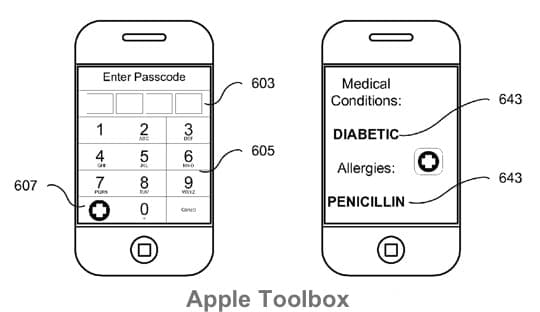The U.S. Patent and Trademark Office (USPTO) published a patent application today from Apple that describes enhanced techniques to show emergency contact information and medical records on a locked device.
The patent, entitled “EMERGENCY INFORMATION ACCESS ON PORTABLE ELECTRONIC DEVICES” describes improved techniques for facilitating emergency access to one or more contacts stored on a portable electronic device, where one or more contacts on the portable electronic device are designated as emergency contacts.
The patent appears to extend the existing medical ID emergency feature, which can be shown on an iPhone’s lock screen in iOS 8. However, there are additional features and the ability to make a call to predetermined contacts, rather than simply making an emergency services call or viewing medical records.
Apple patent background
Portable electronic devices, including mobile phones, PDAs (Personal Digital Assistants), and portable media players have become a near-ubiquitous part of daily life. As these devices evolve, more and more people are turning towards portable electronic devices that combine two or more of these functions into a single device i.e. smartphones. The utility of these devices has made it increasingly likely that people who own them will rarely leave their homes without them.
One type of application that runs on many of the aforementioned portable electronic devices is an address book. This address book is typically used to store contact information, including telephone numbers, such that the owner of the portable electronic device is able to retrieve this contact information at will. However, the address book and other information on the portable electronic device is often accessible only to the person who owns the portable electronic device, since it is common for this type of device to be locked by the user to prevent unauthorized access.
Many portable electronic devices incorporate a password-lock feature, wherein a password must be entered before the device can be utilized. For example, on a typical password-locked mobile phone, any person who attempts to access information stored on the mobile phone will be presented with a password prompt and prevented from using the mobile phone until such a time as the correct password has been entered.
Typically, access to a locked portable electronic device is prevented by the use of a screen lock. Hence, to gain access to the address book, the user can enter a password to unlock the screen. However, there are situations when it would be desirable for someone who does not know the password to unlock a password-locked portable electronic device to be able to access at least some of the information on that portable electronic device.
Currently, most smartphones display a welcome screen that allows their owners to display information determined by the user when a device powers up, while maintaining the privacy of the other data on the device by requiring a password for access other information beyond that contained in the welcome screen. However, the owner of the device may not care to include identifying information or any other personal information on that screen for many reasons including, for example, privacy concerns. Thus, there is a need for improved methods for allowing the owner of a portable electronic device to specify and customize information that can be accessed on a password-locked portable electronic device without entering the password.
Additionally, the portability and increasingly smaller sizes of portable electronic devices have the drawback of making them susceptible to loss. The design of most portable electronic devices is such that it is difficult or impossible to identify the owner of the device without extensive detective work, which is undesirable for a variety of reasons, including owner privacy concerns.
Thus, there is also a need for improved methods to provide information to aid in the return of a lost portable electronic device to its rightful owner.
Details
In one embodiment of the patent, the user of the device can enter various personal information, namely, emergency information, device where it is stored. Typically, the device has the “software lock” engaged when it is turned on or when not used for a period of time. However, even with the lock engaged, the emergency information for the user can be made available while other information remains unavailable. In one embodiment, the lock screen can be bypassed to gain access to the emergency information.
As an example, assume that the owner of the device has entered predetermined medical information that is to be available even if the software lock is engaged. In such case, the medical information remains available to anyone possessing the device. If the owner is injured in an accident, the device can be used to access the predetermined medical information. For example, a medical care provider can easily interact with the device and in doing so, the software lock can be bypassed and the medical information viewed (such as allergies, existing medications, blood type, medical conditions or other health information, etc.), as well as emergency contacts.
Patent credits
Apple credits Steven Charles Michalske (Sunnyvale, CA) as the sole inventor of U.S. patent application number 20150052618.

